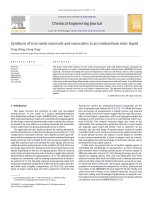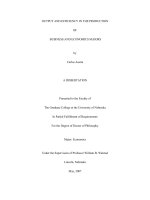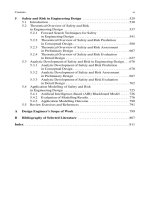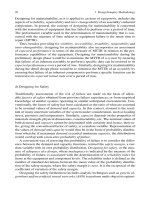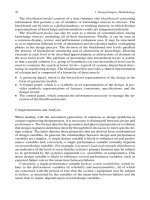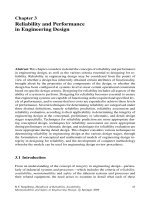Antecedents of service design effectiveness and efficiency in an integrated framework
Bạn đang xem bản rút gọn của tài liệu. Xem và tải ngay bản đầy đủ của tài liệu tại đây (1.14 MB, 125 trang )
ANTECEDENTS OF SERVICE DESIGN
EFFECTIVENESS AND EFFICIENCY
IN AN INTEGRATED FRAMEWORK
ZHOU QI
(B.Eng, Tongji University)
A THESIS SUBMITTED
FOR THE DEGREE OF MASTER OF ENGINEERING
DEPARTMENT OF INDUSTRIAL AND SYSTEMS ENGINEERING
NATIONAL UNIVERSITY OF SINGAPORE
2010
Acknowledgement
I have been extremely fortunate to learn from a number of professors and colleagues
during my study in National University of Singapore. It is a pleasure to convey my
gratitude to them in this acknowledgment.
First and foremost, this thesis would not have been possible without the guidance
from A/Prof. Tan Kay Chuan. His thoughtful and helpful advice brought me to the
field of service research, which I found I am particularly interested in later on. His
always prompt replies to my questions and confusions effectively kept me
concentrated on my research. Besides the guidance and advice on research, Prof. Tan
also cared about my learning and personal growth. He granted me the opportunities to
work with consultants from NUS - Office of Quality Management, which really
extended my vision and experience from basic research to applied research.
I am grateful to Dr. Chai Kah Hin and Dr. Yap Chee Meng, who served as my thesis
committee. Their questions and suggestions during my oral qualifying examination
helped me narrow down my research questions and essentially contributed to the later
part of my research.
I am indebted to many of my colleagues who supported and encouraged me in the
past four years. Ayon Chakrabarty, Ms. Xin Yan, Goudarzlou Atarod, Usman Asad,
and Ms. Xu Bin, thank you for the time discussing research methods, interesting
papers and survey workflows with me and all the help you provided. You are my
friends for life time.
I would like to thank Department of Industrial and Systems Engineering for the
financial support on my conference trip to Germany. Special thanks to Ms Ow
Laichun who made everything smooth and efficient, from the moment I received the
i
offer of NUS research scholarship to now when I am about to submitting my thesis. I
am also grateful to Prof. Xie Min, Dr. Chai Kah Hin, and Prof. Tan Kay Chuan and
IEEE Engineering Management Section Singapore Chapter for involving me in IEEM
and ICMIT conferences as a student helper. The enriching conference experiences in
Thailand, Hong Kong, Singapore made my life more colorful.
I would also like to show my gratitude to my labmates, Ms. Chen Liqin, Ms. Fu
Yinghui, Ms. Bae Minju, Dr. Liu Shubin, Dr. Han Dongling, Markus Hartono and my
housemates Ms. Mu Shifeng, Ms. Wang Yue, Ms. Liu Chen, Ms. Jiang Yixin, Li Juxin
and Wang Qiang. My life would not be so happy and meaningful in the past four years
without your support and encouragement.
Last but not least, I own my greatest gratitude to my parents, Zhou Deya and Wang
Yun, who showed me the joy of intellectual pursuit when I was a child, who always
motivate me to pursue higher education, and who continuously support me, mentally
and financially. Words fail me to express my appreciation to my wife Dr. Zhao Jing,
whose persistent support has taken the load off my shoulder. Thank You.
Finally, I would like to thank everybody who was important to the successful
realization of this thesis, as well as expressing my apology to those that I could not
mention personally one by one.
ii
Table of Content
Acknowledgement .............................................................................................................................i
Table of Content .............................................................................................................................. iii
Summary ........................................................................................................................................... v
Nomenclature ................................................................................................................................... vi
List of Tables ...................................................................................................................................vii
List of Figures ............................................................................................................................... viii
Chapter 1
Introduction .................................................................................................................. 1
1.1
Why Service Design? ....................................................................................................... 1
1.2
Service Design and Its Effectiveness and Efficiency ....................................................... 3
1.3
Purposes and Significances of This Thesis ....................................................................... 4
1.4
Thesis Structure ................................................................................................................ 5
Chapter 2
2.1
Literature Review ......................................................................................................... 7
Fundamental Definitions .................................................................................................. 7
2.1.1
Service .......................................................................................................................... 8
2.1.2
Service classification .................................................................................................. 10
2.1.3
New service development .......................................................................................... 14
2.1.4
Service design ............................................................................................................ 15
2.2
Service Dominant Logic (S-D logic) .............................................................................. 17
2.3
Extant Service Design Theories ..................................................................................... 20
2.3.1
Theoretical studies ..................................................................................................... 21
2.3.2
Empirical studies ........................................................................................................ 23
2.4
Opportunities in Service Design Research ..................................................................... 24
2.5
Summary ........................................................................................................................ 27
Chapter 3
Theoretical Framework .............................................................................................. 29
3.1
Introduction .................................................................................................................... 29
3.2
Contingency Theory ....................................................................................................... 30
3.3
Service Design Performance .......................................................................................... 33
3.4
Know-How of Service Design Foci ............................................................................... 35
3.4.1
Customer orientation – experience utilization............................................................ 38
3.4.2
Process orientation – formalization and proficiency .................................................. 41
3.4.3
Resources orientation – interaction resources ............................................................ 44
3.5
Capability of Knowledge Management .......................................................................... 48
3.5.1
Knowledge management infrastructure...................................................................... 51
3.5.2
Application of tools and techniques ........................................................................... 54
3.6
Chapter 4
Summary ........................................................................................................................ 58
Data Collection and Analysis ..................................................................................... 61
4.1
Research Method ............................................................................................................ 61
4.2
Non-Response Analysis .................................................................................................. 64
4.3
Data Analysis.................................................................................................................. 65
iii
4.3.1
Formative structure and reflective structure ............................................................... 65
4.3.2
Covariance Based Structural Equation Modelling and Partial Least Squares ............ 71
4.4
Two-step Approach......................................................................................................... 73
4.4.1
Step 1: Assessment of measurement models .............................................................. 73
4.4.2
Step 2: Hypothesis testing .......................................................................................... 77
4.5
Chapter 5
Summary ........................................................................................................................ 81
Discussion and Conclusion ........................................................................................ 83
5.1
Introduction .................................................................................................................... 83
5.2
Predictive Power of Proposed Model ............................................................................. 83
5.3
Antecedents of Service Design Performance ................................................................. 84
5.3.1
Level of experience utilization ................................................................................... 84
5.3.2
Level of process proficiency ...................................................................................... 86
5.3.3
Degree of focus on interaction resources ................................................................... 87
5.4
Interaction Effects .......................................................................................................... 88
5.5
Undiscovered Effects ..................................................................................................... 89
5.6
Conclusion ...................................................................................................................... 90
5.6.1
Theoretical implications ............................................................................................. 90
5.6.2
Managerial implications ............................................................................................. 92
5.6.3
Limitations ................................................................................................................. 93
5.6.4
Future research ........................................................................................................... 94
Reference ........................................................................................................................................ 96
Appendix A: List Fieldwork Interview Questions ........................................................................ 111
Appendix B: Sources of Empirical Evidences .............................................................................. 113
iv
Summary
Service design, which transforms a conceptual service idea to a marketable service, is
a key activity in the new service development process. The failure of service design
not only impacts quality of service delivery but also wastes new service ideas. The
extant studies on service design effectively address the “how” issues of service design.
However, there is certainly a gap in understanding the “how effective and efficient”
issues. Thus, this research attempts to bridge the gap by proposing an integrated
service design framework and investigating the effectiveness and efficiency issues of
service design.
Grounded in the extant studies on service design, the common principles of service
design were identified and strengthened. In short, these principles suggest that service
design needs to utilize customer experience, employ a formalized and proficient
process design, and set up resources for interaction. It is hypothesized that these
design content directly affect service design performance. In addition, based on the
contingency theory, it is proposed that the alignment between content and strategy
also affects performance. Specifically, it is hypothesized the capacity of knowledge
management infrastructure moderates the effects from experience utilization and
interaction resources to service design performance; application of tools and
techniques moderates the effects from experience utilization and process proficiency
to service design performance. The hypotheses were tested using data collected from a
mail survey of service organizations in Singapore.
Overall, this research developed an integrated service design framework and specified
a measurement model for the framework. Through empirical evidences, this research
found that experience utilization, process proficiency and interaction resources all
positively affect service design performance. The interaction between process
proficiency and application of tools and techniques also significantly influences
service design performance.
These results point service designers to the essential elements in service design, which
could help to enhance service design performance. The research framework builds
upon theories in various fields and thus could provide a multi-disciplinary platform
for future research on service design.
v
Nomenclature
CBSEM
Covariance-Based Structural Equation Modeling
CFA
Confirmatory Factor Analysis
CFI
Comparative Fit Index
CK
Capability of Knowledge Management Infrastructure
CO
Customer Orientation
d.f.
Degree of Freedom
EE
Effectiveness and Efficiency
EU
Experience Utilization
FMEA
Failure Modes and Effects Analysis
FP
Foundational Premise
G-D Logic
Goods Dominant Logic
GFI
Goodness-of-Fit Index
IR
Interaction Resources
LVS
Latent Variable Score
NPD
New Product Development
NSD
New Service Development
PF
Process Formalization
PLS
Partial Least Squares
PP
Process Proficiency
QFD
Quality Function Deployment
RMSEA
Root Mean Square Error of Approximation
RO
Resources Orientation
SADT
Structural Analysis and Design Technique
S-D Logic
Service Dominant Logic
SEM
Structural Equation Modeling
SIA
Singapore Airline
TT
Application of Tools and Techniques
VIF
Variation Inflation Factor
vi
List of Tables
Table 2-1: Summary of Service Definitions .................................................................. 9
Table 2-2: Summary of Service Classification Schemes ............................................. 10
Table 2-3: Summary of Classification Schemes of New Services ............................... 13
Table 2-4: Definitions of Service Design from Academic Publications ...................... 16
Table 2-5: Definitions of Service Design from Organizations .................................... 17
Table 2-6: Conceptual Transitions to S-D Logic ......................................................... 19
Table 2-7: Foundational Premises of S-D Logic.......................................................... 20
Table 3-1: Description of Interviewee Profile ............................................................. 29
Table 3-2: Types of Variables in Contingency Theory ................................................. 31
Table 3-3: Conceptual Approaches to "Fit" in Contingency Theory ........................... 32
Table 3-4: Content of Service Design .......................................................................... 37
Table 4-1: Profile of Survey Respondents ................................................................... 63
Table 4-2: Assessment of Non Response Bias ............................................................. 64
Table 4-3: Characteristics of Measurement Items In Reflective and Formative
Structure ....................................................................................................................... 67
Table 4-4: Unidimensionality Assessment for Item Parceling ..................................... 69
Table 4-5: Latent Variable Structure and Measurement Items ..................................... 70
Table 4-6: Comparison between PLS and CBSEM ..................................................... 71
Table 4-7: Indicator Reliability for Formative Structure ............................................. 75
Table 4-8: Construct Validity Assessment for Formative Structure ............................. 76
Table 4-9 Correlations among Latent Variables ........................................................... 77
Table 4-10: Multicollinearity Assessment in Stage 2................................................... 79
Table 4-11: Summary of Model Estimation ................................................................. 80
vii
List of Figures
Figure 1-1: New Service Development Process ............................................................ 1
Figure 2-1: Service Design and Its Related Concepts ................................................... 7
Figure 2-2: Integrated Service Classification Scheme ................................................. 12
Figure 2-3: Classification of Service ........................................................................... 12
Figure 3-1: Basic Conceptual Framework ................................................................... 33
Figure 3-2: Evolvement of Knowledge Based View ................................................... 48
Figure 3-3: Research Framework................................................................................. 58
Figure 4-1: Reflective (left) and Formative (right) Structure of Latent Variables ....... 66
Figure 4-2: Main Effect Model in Stage 1 ................................................................... 78
Figure 4-3: Interaction Model in Stage 2 ..................................................................... 79
viii
Chapter 1 Introduction
1.1
Why Service Design?
Services are the very hub of economic activity in any society (Fitzsimmons and
Fitzsimmons, 2003, pp.3). It is clear that the service sector has become the driver of
economic growth. The strategy of developing and launching new services is the key to
success in the service sector as it is believed that new services could enhance the
competitiveness of service companies (Fitzsimmons and Fitzsimmons, 2003). This is
also an essential strategy for companies to enhance profitability, attract new customers
and create loyalty among existing customers (IFM and IBM, 2007).
Research on new service development (NSD) started to draw attention more than two
decades ago. NSD concepts, success factors and process models are the areas which
have been extensively researched (Zhou and Tan, 2008). However, having been
recognized as one of the key activities in NSD, service design is still among the least
understood topics in service research (Tax and Stuart, 1997; Johnston, 1999; Menor et
al., 2002). A growing number of researchers postulate that successful service can and
must be systematically designed (Bullinger et al., 2003).
Service
Concept
Strategy
Formulation
Idea
Generation
Fuzzy Front End
Business
Analysis
Service
Service Design
and Testing
Test
Market
Successful
Launch
Execution Oriented Back End
Figure 1-1: New Service Development Process
Although at times the terms “service design” and “NSD” are used interchangeably,
service design is differentiated from NSD in that NSD refers to the whole process
from idea generation to successful launch of new services, while service design is
1
usually perceived as part of the NSD process (see figure 1-1). The latter specifies the
detailed structure, infrastructure, and integration content of a service operations
strategy (Johnston, 1999).
The importance of service design has been addressed by many scholars and
practitioners. For instance, from service research scholars‟ perspective, Tax and Stuart
(1997, pp.105) suggested that “One important lesson learned from the quality
movement is that the prevention of service failure, resulting in large part from design
excellence, is the most effective and efficient route to achieving higher levels of
quality and customer satisfaction”. According to Steinke (2008, pp.192), “design
flaws in any part of a system can reduce the quality of services and lead potentially to
poor outcomes for both the individual and the organization. It is tempting to blame
poor quality on the people delivering service but frequently the real culprit is poor
service system design”. Song et al. (2009) showed that service design proficiency is
one of the most important factors for improving final service performance. From
practitioners‟ perspective, Bohmer (2009, pp.217) suggested that “[health care]
operating systems and processes must be deliberately designed to realize great
medical outcomes; past experience suggests that they cannot be presumed to reliably
result from existing organizational and operational arrangements”. Bedford and Lee
(2008, pp.38) emphasized the importance of service design by quoting Howard
Schultz‟s (Chairman and CEO, Starbucks) letter to customers that “the Starbucks
experience as good as it has ever been and even better… in the way stores look, in the
way people service you, in the new beverages and products we will offer.” The above
research results and practices reveal that service design should be paid renowned
attention to, which is also the main motivation of this research.
2
The subsequent sections provide an overview of some popular service design theories
and discuss the research related to the effectiveness and efficiency of service design.
Inadequacies of the extant research on service design and the purposes of this study
will also be summarized. A more detailed discussion on these topics will be presented
in chapter 2.
1.2
Service Design and Its Effectiveness and Efficiency
The effectiveness of the whole NSD has been studied (Jaw et al., 2010; Menor and
Roth, 2008; Froehle et al., 2000). However, the effectiveness and efficiency of
particular stages in NSD process has rarely been investigated. Service design has been
recognized as one of the top priorities for the development of science of service
(Ostrom et al., 2010). Researchers have made several attempts to address the “how”
issues of service design. For example, Kingman-Brundage et al. (1995) proposed the
service logic model to describe how and why a service system works; Ballantyne et al.
(1995) conceptualized four inter-related diagnostic levels in service design, namely
environment setting, process, people and job design; Edvardsson et al. (2000) defined
three main service design components, which further illustrated service design
activities; Stewart (2003) developed and empirically tested the three T model for
service encounter design. These studies, together with several other researchers‟ work
which will be discussed later, provide the theoretical foundations for service design
research. However, on one hand, the existing various service design models may
result in the difficulties for service practitioners to choose which model to adopt for
designing their services; on the other hand, the variety of service design models may
also create barriers preventing academic researchers from promoting service design
3
research. Thus, an integrated service design framework is highly desirable. Previous
studies have effectively addressed the “how” issues of service design. Based on these
studies, a further step is to investigate the effectiveness and efficiency of service
design.
Drawing on the service dominant logic (S-D Logic) and contingency theory, this
study investigates the antecedents of service design performance. Specifically, it
examines the relationships between know-how of service design foci and service
design performance. The service design foci include level of utilizing customer
experience in service design, degree of formalization of service design process,
degree of process proficiency, and degree of focus on interaction resources. In
addition, from a knowledge-based view, this study examines the alignment between
knowledge management dimensions (capability of knowledge management
infrastructure and application of tools and techniques) and service design foci, more
importantly, how the interactions affect service design performance.
1.3
Purposes and Significances of This Thesis
The extant studies on service design have made several attempts to address the “how”
issues of service design. The main research gaps of these studies are summarized
below:
The current studies provided valuable insights on how an abstract service
concept can be transformed into a marketable service. However, there is little research
addressing the effectiveness and efficiency of this transformation process.
4
The main purpose of this research was to investigate the effectiveness and efficiency
of service design based on an integrated service design framework. The specific
purposes of this research were to:
Develop a measurement model for service design effectiveness and efficiency
Investigate the antecedents of service design effectiveness and efficiency
The results of this research may have several contributions to both academic research
on service design and practical service design management. First, this research should
be helpful in better understanding the “how” issues of service design. Second, the
integrated service design framework may lay the foundation for future service design
research. Last but not least, the results of this research may ultimately promote the
concept of “service designers”.
This research focused on service design, a key activity in the execution oriented back
end of NSD process. Thus, the activities in the fuzzy front end are beyond the scope
of this research. Although marketing test is another activity in the execution oriented
back end of NSD, it is not central to this study. Therefore, it is not within the scope of
this research.
1.4
Thesis Structure
This thesis consists of five chapters. Chapter 2 will present a review of studies on
service design and related concepts. Chapter 3 will discuss the theoretical framework
and research design. Hypotheses associated with research framework will also be
developed based on both theoretical and empirical evidences. Data collection process
5
and analysis procedures will be described in chapter 4. Then the results will be
discussed in chapter 5. Finally, chapter 5 also concludes this study with theoretical
and managerial implications, limitations of this study and areas for future research.
6
Chapter 2 Literature Review
In this chapter, first, the fundamental definitions of service design related concepts
will be reviewed. Next, central to this study, the existing theories of service design
will be discussed based on the nature of the studies. In addition, we summarize the
evolvement and key arguments in the Service Dominant Logic (S-D Logic), which is
considered as a potential theoretical foundation of service science (Maglio and
Spohrer, 2008). Last but not least, as an important research area that receives
increased attention in service research community, service design has been considered
by many leading researchers as a promising subject that requires further examination.
The opportunities in service design pointed out by these researchers will be
summarized and discussed in the end of this chapter.
2.1
Fundamental Definitions
Figure 2-1: Service Design and Its Related Concepts
In this section, the definitions of service, new service, news service development and
service design will be reviewed. The relationships among the concepts discussed in
7
this chapter are illustrated in figure 2-1.
2.1.1
Service
Service has been defined in a number of ways over the years. Several studies have
made great efforts to summarize the definitions of service from the 1950s (Cook et al.,
1999; Fitzsimmons and Fitzsimmons, 2000; Edvardsson et al., 2005). An early
definition of service was put forth by Definitions Committee of the American
Marketing Association (AMA). Table 2-1 compiles a list of attempts to define service
by various authors in different fields of research.
As shown in table 2-1, generally there are two approaches to define service. Some
authors define service by listing the activities or industries that compose the service
sector. This provides a useful tool for determining the industries that should be
included in the calculation of relevant statistics for what we consider the service
sector of the economy. Some other authors define service by analyzing the
characteristics that differentiate service from physical product. A well accepted set of
service characteristics, commonly known as IHIP framework, includes Intangibility,
Heterogeneity, Inseparability and Perishability (Lovelock, 1983). However, recently,
Vargo and Lusch (2004a; 2004b) debated that these characteristics are too limited in
scope and they further suggested evolving services and goods into a services-centered
perspective for all economic exchanges. Lovelock and Gummesson (2004) also
argued that the IHIP framework has serious weaknesses as a general underpinning for
the paradigm to differentiate services from goods. They claimed that IHIP is only true
for certain types of services, as it is for certain types of goods.
8
Table 2-1: Summary of Service Definitions
Authors
AMA
Year
1960
Sasser et al.
1978
Quinn et al.
1987
Grönroos
1990
Murdick et al.
1990
Zeithaml and
Bitner
Harvey
1996
1998
Fitzsimmons and 2003
Fitzsimmons
Definitions of Service
Activities, benefits, or satisfactions which are offered
for sale, or are provided in connection with the sale of
goods.
A service is intangible and perishable. It is an
occurrence or process that is created and used
simultaneously or nearly simultaneously.
All economic activities whose output is not physical
product or construction, is generally consumed at the
time it is produced, and provides added value in forms
(such as convenience, amusement, timeliness, comfort
or health) that are essentially intangible concerns of its
first purchaser.
A service is an activity or series of activities of more or
less intangible nature that normally, but not necessarily,
take place in interactions between customer and service
employees and/or physical resources or goods and/or
systems of the service provider, which are provided as
solutions to customer problems.
Service can be defined as economic activities that
produce time, place, form, or psychological utilities.
In simple terms, services are deeds, processes, and
performances.
A service is a result that customers want. Services are
generally obtained by engaging in an interactive
process with the provider.
A service is a time-perishable, intangible experience
performed for a customer acting in the role of coproducer.
To conclude, it is believed that no single definition of service is capable of
encompassing the full diversity of services and the complex attributes that accompany
them. Due to the difficulty in describing and defining services, many authors turn to
classification schemes of services.
9
2.1.2
Service classification
The main purpose of introducing service classification schemes is to facilitate
developing meaningful strategies or guidelines for marketing and operations
management (Cook et al., 1999). It is also a way of helping service organizations to
learn from each other on the appropriate management and control methods (Silvestro
et al., 1992).
Table 2-2: Summary of Service Classification Schemes
(Adapted from Dotchin and Oakland, 1994; Cook et al., 1999; Bullinger et al., 2003;
Lovelock and Gummesson, 2004; Shafti et al., 2007)
Authors
Year Service Classification Schemes
Copeland
1923 Convenience; shopping; specialty goods
Bourne
1956 Degree of brand conspicuousness
Judd
1964 Rented goods services; owned goods services; nongoods services
Rathmell
1974 Type of seller; type of buyer; buying motives; buying
practice; degree of regulation
Shostack
1977 Degree of tangibility and intangibility of each good or
service
Hill
1977 Services affecting persons versus those affecting goods
Ryans and
1977 Customer's ability to switch firms
Wittink
Chase
1978 Extent of customer contact required in service delivery
Sasser et al.
1978 Percent of tangible goods versus intangible benefits
contained in each service "bundle"
Thomas
1978 Equipment-based; people-based
Lovelock and
1980 Profit; public; non-profit organizations
Young
Lovelock
1980 Basic demand characteristics
Mills and
1980 Personal interface between the customer and the service
Margulies
organization
Bell
1981 Matrix based on tangibility and extent of customer
involvement
Fitzsimmons and 1982 People-changing; people-processing; facilitating
Sullivan
services
Maister and
1982 Extent of customization
Lovelock
Dilworth
1983 Unit or batch; mass production
Grove and Fisk
1983 Audience size; customer contact
Kotler
1983 People versus equipment-based
Lovelock
1983 Tangible versus intangible service act
10
Stiff and Pollack
1983
Zvegintzov
Silpakit and Fisk
Bowen and
Bowers
Goodwin
Murphy and
Enis
Schmenner
1983
1985
1986
Customer contact; economic concentration; degree of
capital intensity
Quasi-production
Customer contact; customer participation
Customer contact; intangibility
1986
1986
Power; commitment
Convenience/preference/shopping/specialty products
1986
Bowen and
Jones
Shostack
HaywoodFarmer
Larrson and
Bowen
Bowen
Mersha
Wemmerlov
1986
Degree of labor intensity, customer-provider interaction,
and service customization
Goal incongruence; performance ambiguity
1987
1988
Complexity; divergence
Degree of labor intensity, interaction, and customization
1988
Diversity of demand; customer participation
1990
1990
1990
Silvestro et al.
Kotler and
Armstrong
Karmarkar and
Pitbladdo
Kellogg and
Chase
Kellogg and Nie
Lovelock and
Yip
Rust and Metters
1992
1994
Degree of contact; degree of customization
Broadened definition of traditional customer contact
Nature of interaction; degree of routinization of service
process; objects toward which service activities are
directed
Processional service; service shop; mass service
Intangibility; inseparability; variability; perishability
1995
Absence of finished inventories; joint production
1995
Communication time; intimacy; information richness
1995
1996
Bullinger et al.
Lovelock and
Gummesson
Shafti et al.
2003
2004
Service process structure; service package structure
People-processing; possession-processing; informationbased service
Customer behavior models; service quality impact
models; normative service models
Contact intensity; variety
Non-ownership
2007
Customer contact; front value added
1996
There are prolific studies on service classification schemes during the past forty years
(see table 2-2). However, few of these classification schemes have been empirically
tested.
11
For-Profit
Product
Service
Marketing Oriented
Integration
&
Interaction
Private
Not-forProfit
Process
Operations Oriented
Customization
Quality
Public
Social/Economic Environment
Macro
Micro
Figure 2-2: Integrated Service Classification Scheme
(Source: Cook et al., 1999)
Based on the analysis of 39 classification schemes from 1960s, Cook et al. (1999)
built an integrated classification scheme, as shown in figure 2-2. This integrated
scheme illustrates the studies on service classification from macro view and micro
Low
Contact intensity
High
view as well as marketing-oriented view and operations-oriented view.
Service Type C
Service Type D
Examples:
Call Center
Fast Food Restaurant
Examples:
Consulting
Medical Examination
Service Type A
Service Type B
Examples:
Teller Machine
Customer Self-service
Examples:
IT Outsourcing Service
Life Insurance
Low
High
Variety
Figure 2-3: Classification of Service
(Source: Bullinger et al., 2003)
12
As mentioned earlier, though there are various studies on classification schemes in the
history, most of them are theoretical in nature and lack of empirical evidence.
However, the study conducted by Bullinger et al. (2003) is an exception. Two
dimensions of service, as shown in figure 2-3, are derived empirically from a large
scale survey of 282 service organizations. Even though we admit that empirically
derived service classification scheme has more practical meaning, we do not deny the
implications of the conceptual and theoretical service classification schemes, as they
do serve to “focus our thoughts and provide an easily understood description of
complex relationships” (Verma, 2000, pp.23).
Table 2-3: Summary of Classification Schemes of New Services
Authors
Carman and
Langeard
Scheuing
Kleinschmidt and
Cooper
Avlonitis et al.
Crawford and Di
Benedetto
Hipp and Grupp
Year Classification Schemes of New Services
1980 Scheme one: core; peripheral; Scheme two: multi-site;
multi-segment; multi-service
1989 Modification; differentiation; market creation; market
expansion; market extension; diversification
1991 High innovative; moderately innovative; low
innovative products
2001 New to the market service; new to the company
service; new delivery process; service modification;
service line extension; service repositioning
2002 New to the world; new categories entries; additions to
product lines; product improvements; repositioning
2005 Knowledge-intensive services; network-based services;
scale-intensive services; supplier-dominated services
Menor and Roth (2007, pp.826) defined a new service as “an offering not previously
available to the firms‟ customers that results from either an addition to the current mix
of services or from changes made to the service delivery process”. Similar to the
classification schemes of services, new services can also be classified in several ways.
Table 2-3 summarizes six classification schemes published during the past three
13
decades. It is not difficulty to observe that some of these classification schemes are
based on how innovative the new services are (Scheuing and Johnson, 1989;
Kleinschmidt and Cooper, 1991; Avlonitis et al., 2001; Crawford and Di Benedetto,
2002; Gounaris et al., 2003); some are based on the functions of new services
(Carman and Langeard, 1980); and some are based on the dominant factors in new
services (Hipp and Grupp, 2005). Among these classification schemes, the approach
based on the innovativeness of new services is more popular than others.
2.1.3
New service development
New service development usually refers to the whole process from idea generation to
the launch of new services (Edvardsson et al., 2000). It received increased attention in
the past two decades (Johne and Storey, 1998; Alam, 2002). While the development of
new services has long been considered by scholars and managers as an important
competitive necessity in many service industries (Johnson et al., 2000; Tidd and Hull,
2003; Miles, 2005), it has remained among the least understood topics in the service
management and innovation literature (Johnson, Menor et al., 2000; de Jong and
Vermeulen, 2003; Drejer, 2004). Johne and Storey (1998) provides a very good
literature review on the development of NSD research in its first decade. A
bibliographic analysis of the literature in a more recent decade suggests that NSD
success factors and NSD models are the two areas that have been extensively
researched (Zhou and Tan, 2008).
Various issues relating to success factors have been examined. Studies on success
factors have been conducted in functionally organized firms and also project-based
firms (Blindenbach-Driessen and van den Ende, 2006). Meanwhile, specific success
14
factors in the different stages of the NSD process were also examined. An incomplete
list that has been examined include organizational culture, process formality,
communication, leadership, cross functional teams, decision architecture, fitness
between requirements and capabilities, expert frontline personnel, empowerment, and
market orientation (Stuart, 1998; Chryssochoidi and Wong, 2000; Lievens and
Moenaert, 2000a; de Brentani, 2001; Blazevic et al., 2003; Edvardsson and
Gustavsson, 2003; Van Riel and Lievens, 2004; Ottenbacher et al., 2006)
Johne and Storey (1998) once pointed out that there had not been more effort to
develop a specific service development model. However, recent research development
specifically addressed this gap. The process model and the systematic model are the
two major models that have been examined. The main idea of process model is that
NSD activities should follow a stage by stage process and these stages can be either
linear or parallel (Alam and Perry, 2002). Systematic model is based on organizational
factors and it considers actors, decision-making process, and transformations during
the NSD process (Stevens and Dimitriadis, 2005). In this research, we look at NSD
from the perspective of process model that NSD consists of a series of stages that
introduce new service ideas, evaluate and develop these ideas, test the new services
and finally launch the new services.
2.1.4
Service design
Service design research grows up in the ground of new service development research.
Due to the wide interest in service design from both academic and practical fields,
service design has been defined in various ways. We systematically collect these
definitions and summarize them into two tables based on the origins of these
15
